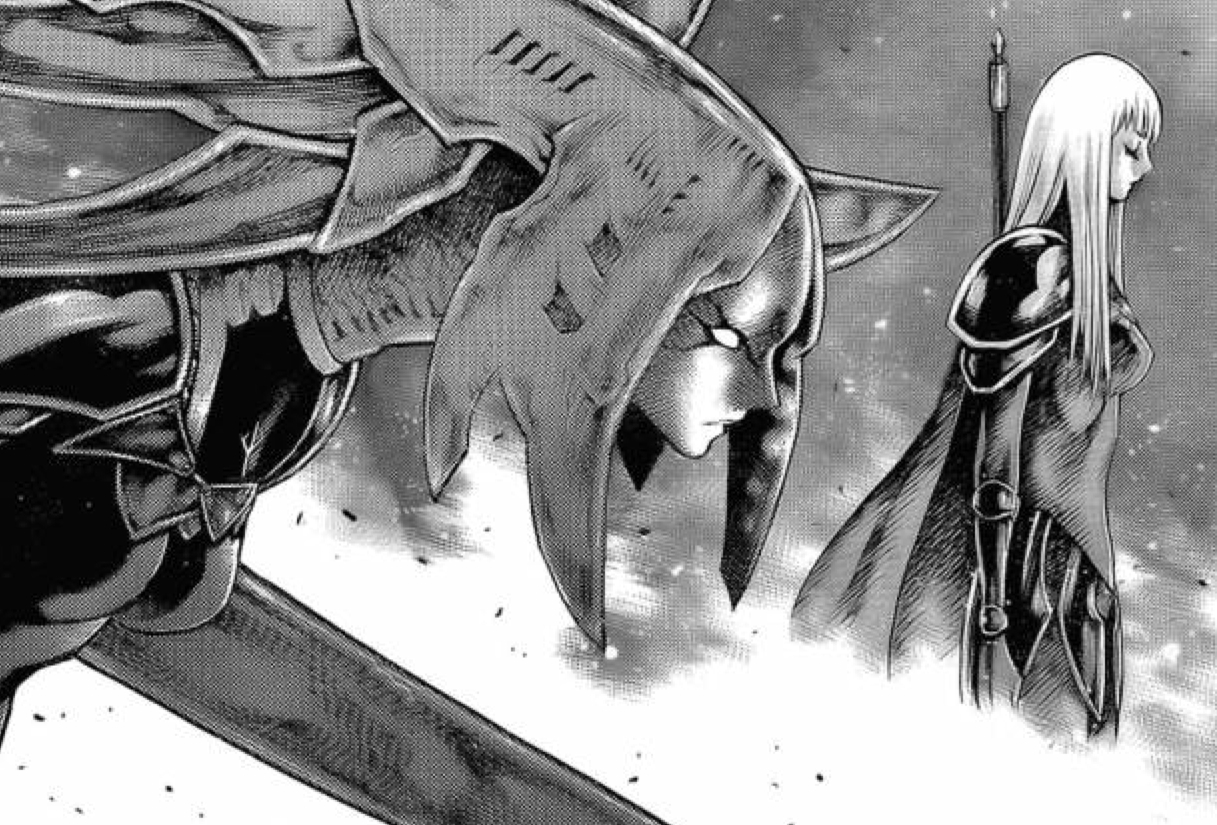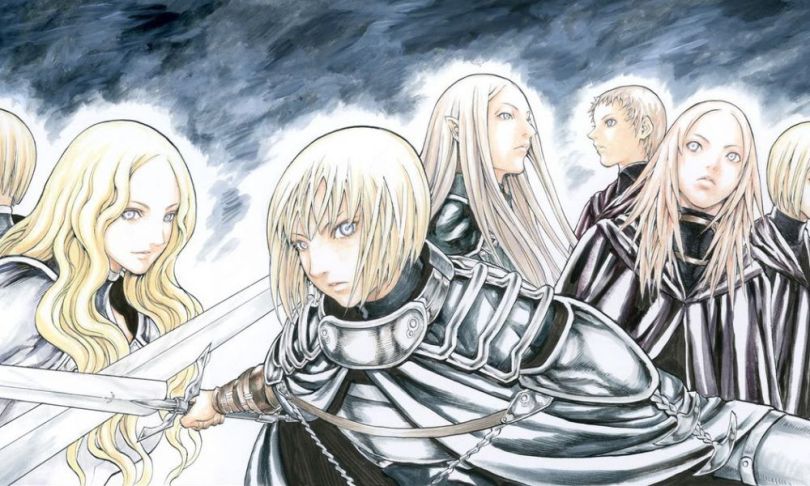Title: クレイモア; Claymore
Mangaka: 八木教広; YAGI Norihiro
Serialisation period: 2001~2014
My personal rating:

It’s been a long while since I wrote a review, but in this post I want to talk about one of my ultimate favourite manga of all time – Claymore, by Yagi Norihiro. This is a dark fantasy shônen series that was serialised in Monthly Shônen Jump and then Jump Square. With many shônen series that are all the rage nowadays, I find Claymore to be a breath of fresh air. It truly piqued my interest when I picked it up more than five or six years ago, but I find it all the more unique when I pit it against the likes of famous and popular shônen manga, as much as I enjoy those as well. I daresay that this series is underrated.
Claymore had been adapted into a 26-episode anime series back in 2007, which was a decent adaptation of the early arcs of the story but unfortunately did not propel the series itself into mainstream success. Ever since I became more invested in anime and manga, I haven’t found any fan of this series in the community around me, except for one friend. The manga is decently ranked at #213 (as of writing) on MAL, but I just never ever see any talk about it at all outside of its subreddit. Maybe there was once a lot of hype over Claymore but if there really had been, that era is now long over and has, in my opinion, completely faded away.
Just what is Claymore about? According to VIZ,
Sword-wielding women warriors are humanity’s only defense against supernatural beings of appallingly destructive power.
In this story, the reader follows Clare, a female warrior who travels to various villages to eradicate yôma, a type of man-eating monster, for a fee that the Organisation collects later. Clare is one among many female warriors who wield large swords and possess silver eyes and hair. The warriors are ranked from 1 to 47, with each of them being granted a unique symbol as a form of identification. Often referred to as “Claymores,” these warriors are usually feared because of their ‘half-human, half-yôma’ nature. Through a surgery that puts yôma flesh in the bodies of these young girls, they acquire monstrous strength, agility and perception. The warriors can harness their powers in the form of yôki, which they can release as they fight. The more yôki they release in a battle, the more distorted their appearance becomes. Furthermore, if they misjudge their limits and release too much yôki all at once, the warriors may be unable to return to their original state. At this point, they succumb to a process known as “awakening” and turn into Awakened Beings that crave human guts. However, most warriors still wish to die as humans and thus, the Organisation has in place a system known as the “Black Card,” allowing soon-to-be-awakened warriors to end their lives by the hand of their closest Claymore friend.
Unlike most shônen mangas, Claymore features a predominantly female cast, with the few key male characters making appearances as supporting cast. While the cast is markedly lacking in diversity, I appreciate that readers get to know an entire cast of distinctive female characters, each with their own unique personality. Some people may find it puzzling that the traditionally weaker female takes centre stage in an action series with lots of killing and bloodshed, but the male warrior’s decline is explained in the story later on. Male Claymores did exist, but not anymore.
Another point that I have to applaud the manga for, is the way the female body is represented as part of the entire picture. Fans of anime and manga are unlikely to bat an eyelid at the fan-service that many female characters usually serve to provide in a shônen series – fortunately, some of these characters take on more than just a fan-service role, but also undergo character development and are granted their own arcs, which adds a significant and much-appreciated dimension to themselves.
One thing I appreciate about the manga is the way the key characters are all extremely distinguishable. I have had problems with certain manga where some characters looked so similar to one another, it made keeping up with the interactions a great challenge. The characters in Claymore, however, were each very unique and had different trademark fighting techniques that also made every character more recognisable in their own way. In addition, Yagi-sensei’s designs for the awakened beings and Abyssal Ones are where he really fleshes out his creativity.


Since all the warriors are so interesting, with heart-wrenching backstories to boot, picking a favourite can be really difficult. I do have a few favourites, but instead of talking about them I would like to give the pair Teresa and Clare a special mention. It is through their mother/daughter or sister bond (however you choose to see it) that readers get to see, for the first time, how “human” the warriors’ hearts can be, in spite of the yoma flesh in them, the solitary lives they lead and the resignation to living their lives out as Claymores. The concluding arc of the story also centres heavily on this pair, bring the story to a full circle as Clare achieves her goal of avenging Teresa and finds closure from her loss of Teresa.
There is almost close to no romantic elements in this manga, which is perfectly fine for me as I enjoy the focus on the character development of our main cast as they seek to unravel the mysteries behind the Organisation and the land they live on. However, Clare does have a love interest in the form of Raki, a young boy she rescues in the very first arc of the series. Given Raki’s immaturity and young age at the beginning of the story, I find it unsurprising that he was rather unpopular among fans, also because of the fact that he might become a distraction from the action-packed storyline. However, we see that he becomes a great source of support for Clare eventually – although the pair are forced to separate, we meet Raki again after the time skip, now grown up with formidable sword-wielding skills that he polished under Isley. He reunites with Clare, who has not aged a single day since they first met. It is very probable that they continued to be companions to each other after the main events of the story comes to an end.
Perhaps the ending of Claymore feels somewhat incomplete in the eyes of fans who would have preferred to see further world-building and more elaboration on the Organisation’s enemies, the dragon’s kins. Personally, however, it did not bother me at all that Yagi-sensei did not expand the story beyond the island – and in fact, I like it best this way. I realise that some manga artists do put in a lot of effort to build an entire world as the story moves along in order to shed light on the major conflicts that the protagonists are embroiled in. It is a bold move and requires a whole lot of consideration on their part. (If not done well, this could end up creating an extremely convoluted plot.) But at the same time, I also appreciate the simplicity of Claymore’s ending. The warriors find closure and go on to live out their lives for their own sake, free from the Organisation’s control. They do not care for the war that goes on beyond their island’s borders and no longer wish to be embroiled in any kind of fighting. To me, this type of ending is complete on its own.

That’s all I have for now about Claymore. There’s a lot more I could talk about, but not without spoiling way too much for anyone who has yet to read it. I truly recommend this to any fan of the dark fantasy genre. The fight scenes are easy to follow thanks to Yagi-sensei’s considerations; the story and characters are fantastic as well. As with any long-running series, Claymore does have weak areas, particularly in the later half, but the concluding chapters do a great job at redemption.

You must be logged in to post a comment.